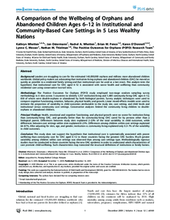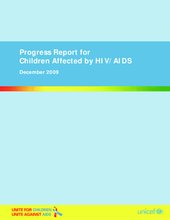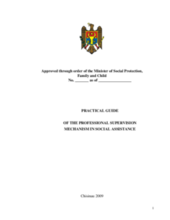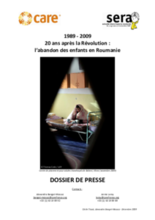Demographic Data
|
Sources: World Bank, UNDP, UNAIDS, DHS 2013 |
Displaying 13241 - 13250 of 14389
Global policy makers are advocating that institution-living orphans and abandoned children (OAC) be moved as quickly as possible to a residential family setting and that institutional care be used as a last resort.
The latest in a series of reports produced by UNICEF on the status of orphans and vulnerable children (OVC). This is an easy-to-use reference document for policymakers and key stakeholders who work in the response for orphans and vulnerable children. It presents the 17 indicators described in the Guide to Monitoring and Evaluation of the National Response for Children Orphaned and Made Vulnerable by HIV/AIDS
As a result of the HIV/AIDS pandemic, there are now more than 12 million orphans in sub-Saharan Africa. The majority of these children have been absorbed into their extended families.
This scoping study assesses the nature and extent of the evidence base in relation to increasing the number of care leavers in ‘settled, safe accommodation’. The Social Care Institute for Excellence (SCIE) carried out the study on behalf of the Centre for Excellence and Outcomes in Children and Young People’s Services (C4EO), between November 2008 and February 2009.
This doctoral thesis by Hye-Young Lim examines the laws around the recognition of child-headed households in South Africa, particularly in the context of HIV/AIDS.
The Practical Guide of the Professional Supervision Mechanism in Social Assistance was developed in cooperation with the Ministry of Social Protection, Family and Child (Moldova), with the technical support of the "Support in the Deliver
Vingt ans ont passé depuis la Révolution de 1989, symbole de la chute du Conducator Nicolae Ceausescu. Pourtant, force est de constater que l’empreinte laissée par la politique pro-nataliste est toujours aussi forte. La Roumanie présente la spécificité d’être le seul pays où les abandons d'enfants aient été encouragés et organisés par l’Etat. Cette politique de Ceausescu poursuivait un triple objectif démographique, idéologique et politique.
Provides global estimates of the number of highly vulnerable children; a summary of United States Government (USG) assistance programs for highly vulnerable children; a summary of progress coordinating the response among USG agencies; key strategic issues and opportunities; priorities for 2009–2010 and beyond; and a summary of the results and achievements of USG assistance
Policy recommendations and conclusions from November’s high level conference focused on gathering data, harnessing political will, strengthening systems, securing funding, and increasing public and political understanding regarding children without adequate parental care
Provides recommendations for World Vision and partner agencies on general alternative care principles and analysis of alternative care models.









